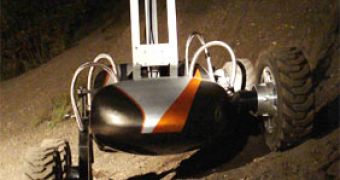NASA is finally talking business and is clearly determined to put a manned mission on the surface of the Moon within the next decade and, why not, to establish a lunar base on our only natural satellite. The new lunar rover demonstrated by the NASA team during the Space Exploration Conference, which took place between 26 and 28 February in Denver, will have the capability of searching for ice water and oxygen-rich soils on the arid surface of the Moon.
It's easy to put a man on the Moon, however, establishing a permanent lunar outpost on its surface is another deal, says Bill Larson, deputy manager of the In-Situ Resource Utilization project. We cannot draw resource from the Earth forever to power such future Moon bases; it is simply too expensive. And the worst part of all the process is the fact that we don't know much about the resources present on the surface of the Moon, even though it is the closest celestial body to Earth.
The challenge is even greater when considering that such a vehicle should be able to work in continuous darkness conditions with extremely low reserves of power. Further still, finding water and oxygen on the Moon basically implies drilling into the lunar soil. The Moon's gravitational pull is only a sixth of that we experience on a daily basis on Earth, meaning it will be incredibly difficult for a particular rover to maintain stability while drilling through the regolith soil. To make a small comparison, water ice in relation to the gravitational force on the Moon could have a consistency comparable to that of concrete.
In late 2007, the team working at the construction of the lunar rover demonstrated that it was indeed capable of drilling through the Moon's surface without losing stability. A laser light camera had the role of selecting the drilling spot, after which the rover initiated the drilling process in order to collect soil and rock samples.
In the course of this year, NASA has in plan the installation of ISRU's Regolith and Environment Science and Oxygen and Lunar Volatile Extraction experiment, or RESOLVE, which will have the task of collecting samples, crushing them and heating them in order to analyze the chemical composition.
The Moon's surface, in contrast to the Earth's, has remained relatively unchanged ever since its creation more than 4.5 billion years ago, except of course the action of the solar wind and periodic interactions with asteroids and comets. Let's say hydrogen is found of the Moon. By extracting oxygen gas from iron oxides, one would be able to obtain water, critical for life, but for the production of energy as well.
Gerald Sander, manager of the ISRU program, says that the new lunar rover is a hardware combination of two different technologies created by NASA, albeit even if the two will not work correctly together, or worst, they will not be used on the Moon, and there would still be a valuable lesson to learn from the experience.
The teams collaborating in the creation of the lunar rover is composed of the Carnegie Mellon institution, responsible for the design and testing, the Northern Center for Advanced Technology which built the drilling system, the Glenn and Ames Research Centers that contributed with the power management and navigation systems.

 14 DAY TRIAL //
14 DAY TRIAL //